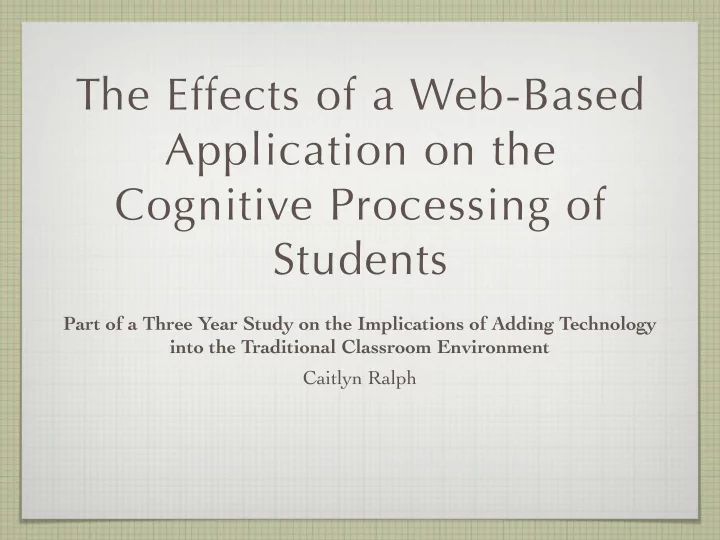

The Effects of a Web-Based Application on the Cognitive Processing of Students Part of a Three Year Study on the Implications of Adding Technology into the Traditional Classroom Environment Caitlyn Ralph
WHY? The twenty-first century’s change in learning Online testing (FCAT, EOC) Online classes (FLVS, SCVS) Need to test and analyze these alterations effect on learning WWW.FLVS.NET
Previous Years’ Studies 9th grade: Face-to-face (traditional) vs. webcam (technological) tutoring 10th grade: Face-to-face vs. webcam immediacy (group working interactions) Elementary/middle school students Traditional environment more efficient
Intrinsic + Extraneous + Load = Total Cognitive Germane What is wanted: More Germane Less Extraneous ! ! What is not Less Germane More Extraneous wanted: ! ! Cognitive Diagrams
How? Paper-based comic activity (traditional method) Redesigned with four parts Web-based application (technological method) Information is identical (intrinsic cognitive load) 130 students (32 traditional/98 technological)
Web-Based Application
Web-Based Application
Web-Based Application
Web-Based Application
Unpaired T-Test P-Values Means and Standard Deviations ���� ������������������ ������� ������������ �������������������� ����� ����� �������� ������ ��� ������������������ ����� ����� ������ ������ �� ������������������ ����� ������ ������������� ����� �� ���������������� ���� ������ ������������������� ������ �� ������������������������� ����� ����� ����������������������� ����� ����� ������������������������������� �������������� ����� ������������������ ���������� �������� ���� Training Efficiency Formula Efficiency ( E ) is positive when performance ( P ) > mental effort ( M ), negative if P < M , and zero if P = M . Ideally, M < P , therefore the more efficient a strategy, the higher E value. E = P - M / √ 2 Ef Data Analysis
Traditional vs. Web-Based Survey Overall Averages Average Level Of Agreement 5 4 3 2 1 0 Traditional Web-Based Method Average Graphs
Traditional vs. Web-Based Accuracy 100 90 80 70 60 Score 50 40 30 20 10 0 Traditional Web-Based Method Average Graphs
Traditional vs. Web-Based Average Mental Effort Average Level Of Mental Effort 9 8 7 6 5 4 3 2 1 0 Traditional Web-Based Method Average Graphs
Traditional vs. Web-Based Average Training Efficiency Scores 4 Average Training Efficiency 3 2 1 0 -1 -2 -3 -4 Traditional Web-Based Method Graphs
Conclusions and Discussion Activity was successful (based on the means) Limited difference between traditional and technological methods Relationship with previous studies Inverse relationship Younger students: Gradual incorporation Older students: More rapid All ages: Progressive exposure (increase experience/accuracy) Other ramifications
Acknowledgments I would like to thank: Dr. Vogel-Walcutt Dr. Dahl Mr. Okraski Mrs. Moosavifazel Contact: Caitlyn Ralph caitlyn.ralph13@gmail.com
Recommend
More recommend